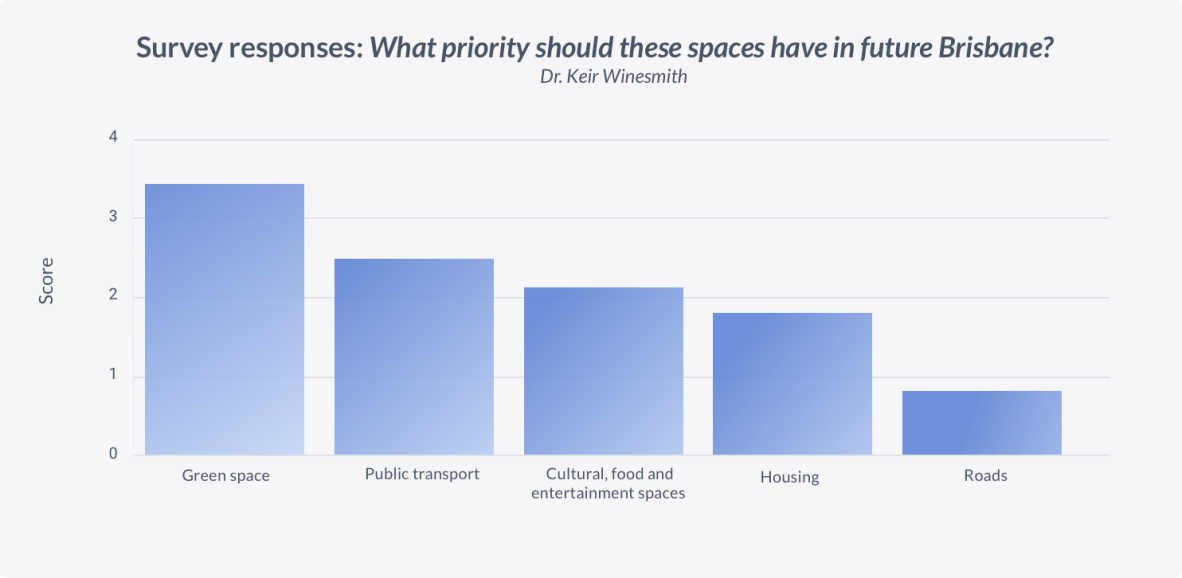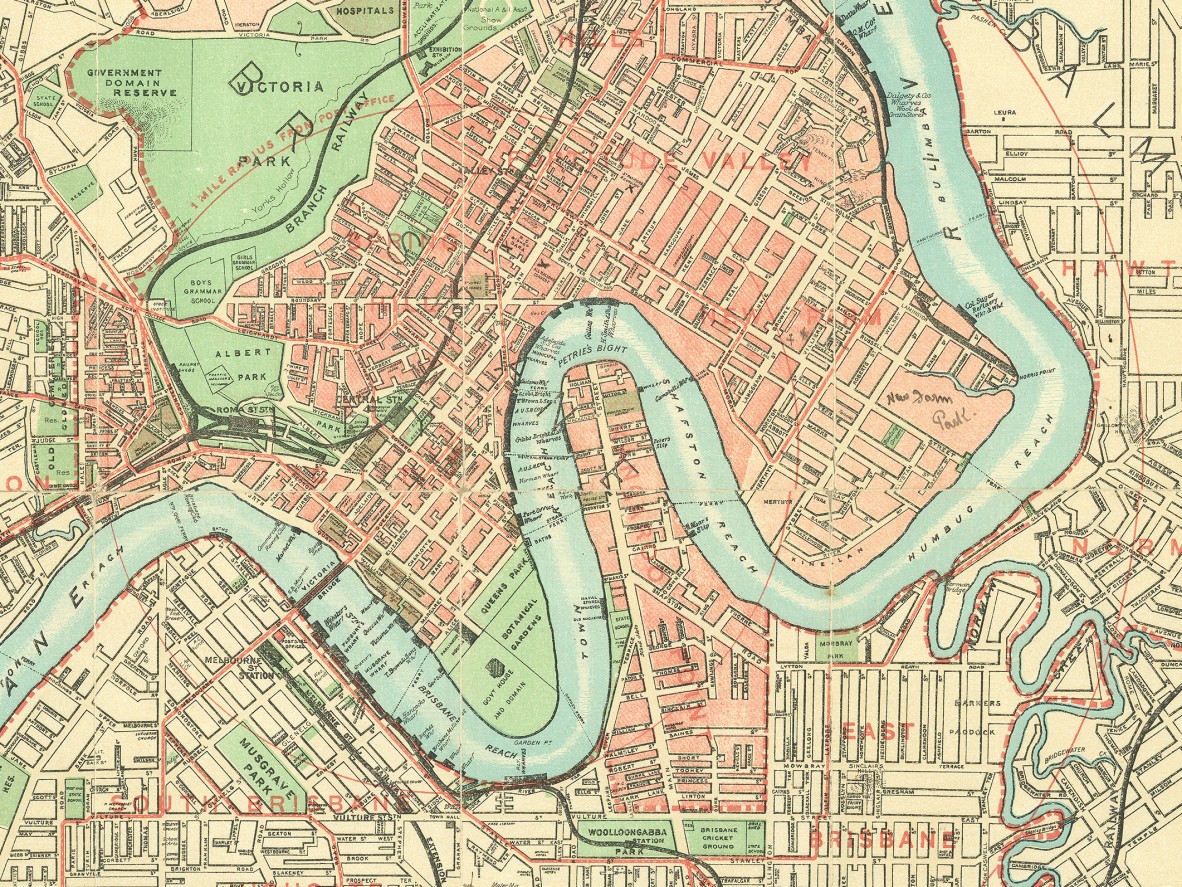Mapping Future Brisbane, part 2: Shaping the future
By Dr. Keir Winesmith, Digital Collections Catalyst 2020 | 7 September 2020
How do the people of Brisbane see their city?
Alongside exploring the wonderful and complicated maps of my first post, I have been talking to the people of Brisbane, with a focus on those who have a personal or professional stake in Brisbane’s future. These wide-ranging conversations have helped shape and enrich the project to use State Library’s historical maps, and other inputs, to create a machine learning model that will visualise different possible futures for the city. I’m incredibly grateful to those who have given up their time to speak with me.
I’ve met and spoken with Indigenous and non-Indigenous people of Brisbane, urban planners and designers, historians, writers, artists, academics, and loads of bartenders, barristers and restaurant staff. I’ve also met with leaders and staff from State Library of Queensland, Brisbane Open House, Cross River Rail Delivery Authority, QLD Government Architect, QLD Museum of Lands, Mapping and Surveying, and Brisbane City Council.
These conversations have guided my thinking and uncovered many incredible resources that I’ll share at the close of the project. Brisbane is a city unafraid to (re)imagine it’s future, and its people are generous and willing to share their visions.

Brisbane 1888 / W. A Clarson (William Alfred) ; Sydney : Illustrated Sydney News ; https://hdl.handle.net/10462/deriv/18696
To compliment these conversations, I have reviewed and analysed the informative and generous submissions to the What’s your vision for future Brisbane? survey that State Library posted at the beginning of the project in June.
It asked:
- What is the first thing you recommend to Brisbane visitors today?
- What priority should: Housing, Public transport, Green space, Roads and Cultural, food, entertainment spaces have in future Brisbane?
- Is maintaining building heights and density or growing green space more important?
- What is your vision for future Brisbane?
First, the data. Across the focus areas, green space was by far respondents’ priority. Next was public transport and cultural, food and entertainment spaces, followed by housing. Roads ranked last by some distance. These responses, in many ways, reflect and add clear priorities to the outcomes of the 2014 Brisbane City Plan and 2018 Brisbane’s Future Blueprint from the Brisbane City Council.

Survey responses: What priority should these spaces have in future Brisbane?
91% of respondents chose Grow green space over Maintain building heights and density, a focus that was born out in all my conversations. Noting that growing, or at least maintaining, green space will mean taller buildings and higher density in some currently low and medium density suburbs to accommodate Brisbane’s growing population.
When asked; What is your vision for future Brisbane? People provided a diverse array of opinions and ideas. I’ve selected a few sentences from the submissions that are emblematic of the rest, noting that some of these are at odds with each other.
How the city feels:
- A “Brisbane that is green and clean; a fun, dynamic and creative city that’s very liveable, friendly and welcoming”
- “Dense, vibrant and safe public spaces”
- “Focus on inner-city density and protecting the green spaces that still remain”
- Brisbane should “continue to modernize itself, value its river and the green spaces, keep the density low”
- End “urban sprawl and the over-development of out-lying regions”
Green, clean and innovative:
- One that “creates a climate change adaptive environment which includes having building regulations that meet environmental targets”
- “A blend of technology and green space where people can work flexibly”
- And “green roofs on high rises, preserved parklands, protected Aboriginal sites and unearthed old sandstone curbs and roads”
Transportation:
- “Improved public transport and affordable housing close to the city”
- “A green and shady, subtropical, walkabout city, which prioritises active transport over cars”
- “I'd love to see Brisbane pivot from its car centric infrastructure and move to a more European urban planning style”
Or as one person put it succinctly; “higher density, better public transport, more green spaces.”

Map of Brisbane and suburbs, 1912 ; https://hdl.handle.net/10462/deriv/221019
Mapping Future Brisbane web interface
My project will use State Library's historical maps, and other inputs, to create a machine learning model to visualise different possible futures for the city. Machine learning is a term used to describe a broad range of predictive computational methods which, most often, take existing data as inputs in order to create new outputs that can then be tested and subsequently used to improve the model.
Along with the maps, desktop research, books, articles and multiple illuminating conversations, the survey answers and visions have informed how I’ll be developing the Mapping Future Brisbane interface.
Given the current pandemic, Mapping Future Brisbane will need to be a web application that’s accessible to anyone without having to travel in person to State Library. As such, I am now designing and developing a web application that has (broadly) three parts.
- Stories:
Stories of the mapping of Brisbane’s past, exploring how the maps and contexts can be used to inform the city’s possible futures.
- Projections:
Use maps, demographics, population projections, currently planned development and machine learning to model future Brisbane.
- Interactive city shaping tools:
People clearly have strong ideas about the city and have repeatedly told me they want to see their own vision for the city, in part I believe, to help inform the third wave of Brisbane’s development and renewal. Consequently, how can I provide users with the tools needed to design and share their vision for Brisbane in a way that’s simple, intuitive and fun?
I look forward to sharing these stories, projections and interactive mapping tools with you. And, I’m especially excited to see the future Brisbanes that you design!
About the author
Dr. Keir Winesmith is the inaugural Digital Collections Catalyst for 2020. He has worked at the intersection of digital, culture and place for the last two decades. Keir created and collaborated on immersive and interactive cultural experiences in Australia, the U.S. and Europe, and in 2018 was named in Fast Company's '100 Most Creative in Business' for his work in this area. He currently leads a small strategic design agency and is an Adjunct Professor at UNSW Art & Design.
State Library created the Digital Collections Catalyst initiative for developers and creatives to support innovative and creative uses of our digital collections and collections data. We are interested in highly creative and experimental ideas that bring together technology with cultural heritage to inspire Queenslanders through State Library collections. Learn more about the Digital Collection Catalyst initiative here.
Comments
Your email address will not be published.
We welcome relevant, respectful comments.